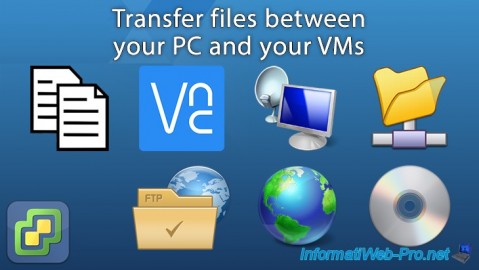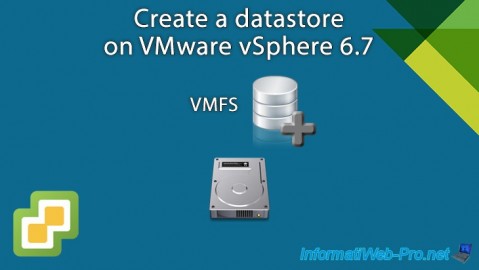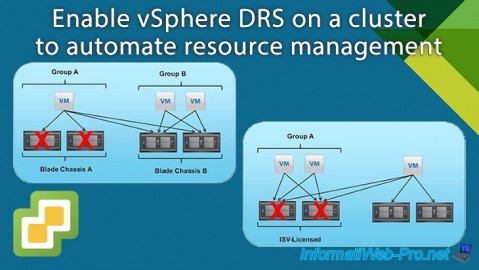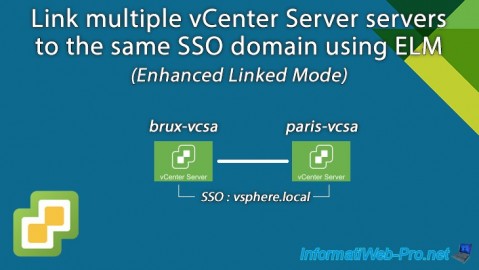Use real (PMem) or simulated (vPMem) persistent memory on VMware vSphere 6.7 via NVDIMMs modules
- VMware
- VMware vCenter Server (VCSA), VMware vSphere
- 05 February 2025 at 08:53 UTC
-

- 2/4
4. Information about the created virtual machine
In the VM hardware of the created virtual machine, you will see:
- Persistent Memory: amount of persistent memory allocated to this virtual machine.
- NVDIMM: the NVDIMM module(s) you added to this virtual machine.

If you look at the objects associated with this virtual machine, you will see that a "PMemDS-..." datastore is there.
This datastore corresponds to the entire persistent memory (PMem) available on your VMware ESXi host.
Warning : if you use simulated persistent memory (PMem) on your VMware ESXi host, this "PMemDS-..." datastore will change its identifier after you shut down or restart your host.
This will prevent your virtual machine from starting in the future, but you will see this problem later in this tutorial.

If you click twice on this link "PMemDS-...", you will be able to see what is in this datastore.
Although it is not referenced in the "Storage" part of your VMware vCenter Server.
As you can see, a new folder with the name of the virtual machine concerned is located in this datastore "PMemDS-...".

If you enter this folder, you will find a virtual hard disk (in .vmdk format) whose size corresponds to the size of the NVDIMM module that you added to your virtual machine.

5. Installing Windows Server 2016
Boot your virtual machine and it will boot to the desired guest operating system installation DVD.
In our case: Windows Server 2016.
Since this operating system supports the use of NVDIMMs, 2 drives appear with unallocated space.
As you will quickly understand, one corresponds to your usual virtual hard disk and the other to the NVDIMM module that you added for this virtual machine.
Select the usual virtual hard disk and click Next.

Wait while Windows Server 2016 installs.

Once the guest operating system is installed, install VMware Tools as you normally do.
From VMware Remote Console, go to: VMRC -> Manage -> Install VMware Tools.

6. Partition the persistent memory (PMem) disk
Once VMware Tools is installed, open Server Manager (if you haven't already) and click: Tools -> Computer Management.

In the "Computer Management" console that appears, go to Disk Management.
As you can see, disk 1 (in our case) is not initialized.
As you will have understood, this is the NVDIMM module that you added to your virtual machine.
Windows Server will automatically show you an "Initialize Disk" window where you can choose what partition type, then click OK.

Once this disk is initialized, right-click "New Simple Volume" on its unallocated space.
In the wizard that will appear, leave the default size and indicate for example "vPMEM" for the volume name.

Then, if you right-click "Properties" on this disk, you will see that it is a "NVDIMM-N disk (vendor: 0289 PID: 0001)" whose location points to memory (... Memory Controller 00 Memory Channel 00 ...).

If you go to the "Volumes" tab of this properties window, you will see that your volume (partition) "vPMEM" appears.

7. Persistent memory retained when restarting a VM
As explained earlier, data stored in persistent memory (PMem) is always retained when using actual persistent memory modules (PMem).
However, this will not always be the case if you use simulated persistent memory (PMem).
Since this is defined at the VMware ESXi host level, it will not be cleared when restarting a virtual machine using this persistent memory (PMem).
For the example, we created a test file on our "vPMEM" partition (which corresponds to the NVDIMM module previously added to this virtual machine).

Properly restart the virtual machine.

Wait while it restarts.

Once the virtual machine restarts, you will see that your "vPMEM" partition will still be present.

If you look in this partition, you will see that the data is still there.

Share this tutorial
To see also
-

VMware 7/1/2022
VMware ESXi 7.0 / 6.7 - Transfer files between your PC and your VMs
-

VMware 4/17/2024
VMware vSphere 6.7 - Create a datastore
-

VMware 2/26/2025
VMware vSphere 6.7 - Enable vSphere DRS on a cluster
-

VMware 11/1/2024
VMware vSphere 6.7 - Enhanced Linked Mode (ELM)

No comment